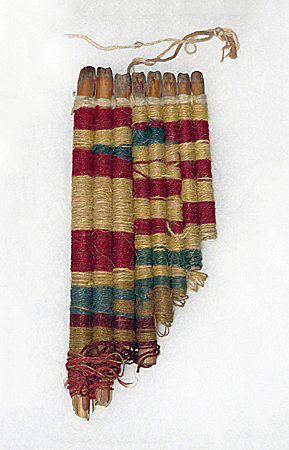
Owner: HWMC
Catalog#: LA-AEBH-16
Edge-blown Flutes
Peru ‘Paracas' Panpipes
Ica Region of Peru
Paracas Culture
Bamboo reed, textile
Prior to 1500 CE
Length: 6.5 in; Width: 2.5 in
Aerophones – Wind Instruments Proper – Edge-blown Flutes
At around the same time that the Chavín culture flourished in the highlands of Peru, the southern arid coast of Peru, known as the Paracas peninsula, witnessed the rise of a new society of farmers and fishermen. This new Paracas culture thrived in this region c. 700 B.C.E.–200 C.E. Seen here is what is believed to be a Paracas panpipe or “antara,” based upon the materials used with each pipe fully wrapped, the coloring of the strings, and the patina from aging. This Pre-Columbian panpipe is made from small bamboo-like reed canes and is covered in traditional polychrome Paracas string. Parts of the cane are used in shamanic healing rites, with the heavier stems made into ceremonial flutes/panpipes. The vivid colored strings wrapped around the eight reed canes to hold them together are executed in shades of blue, red, and beige.
The Paracas culture was an Andean society with an extensive knowledge of irrigation and water management. They are known for making significant contributions in the textile arts. This culture area was in what today is the Ica Region of Peru. Most information about the lives of the Paracas people comes from excavations at the large seaside Paracas site on the Paracas Peninsula, first formally investigated in the 1920s by Peruvian archaeologist Julio Tello.
Resource: https://en.wikipedia.org/wiki/Paracas_culture
